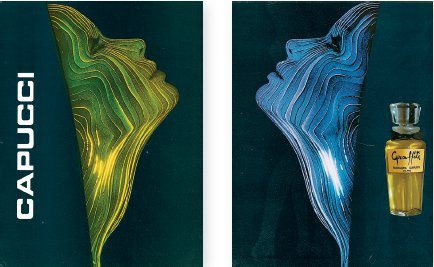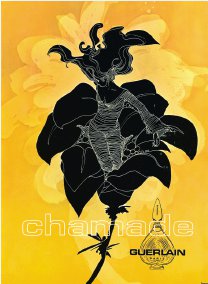Scent and Subversion (18 page)
Read Scent and Subversion Online
Authors: Barbara Herman

by Coty (1967)

Sporting a not-oft-seen yoga/disco look, the model in this 1977 Masumi perfume ad may be in half lotus position in search of Nirvana, but that doesn’t mean she can’t look faaaabulous while doing it! And you can’t see it, but I’m certain the entire ad is illuminated by an out-of-frame disco ball.
Masumi (“Beauty, Truth, and Purity” in Japanese) starts off tart and gives way to a gorgeous soapy rose, pushed by a galbanum-like greenness into what feels like sport-scent territory, with coriander and tarragon the minor keys in its top notes’ key of green. Momentarily, Masumi smells like Estée Lauder’s Aliage, with that galbanum/peach tartness that makes that scent so beautiful, a not-quite-yet-ripe stone fruit married to a tea rose.
It doesn’t take long for its base to signal that this is no sport scent, however: Classic fresh florals, with Rose de Mai in the lead, are dressed up in elegant powderiness thanks to orris, and the gravitas of mossiness thanks to oakmoss and vetiver. With a subtle warming amber accord like the sun in the backdrop, Masumi feels like a hot summer day that’s coming to a close.
Top notes:
Bergamot, lemon, orange, coriander, tarragon
Heart notes:
Lily of the valley, Rose de Mai, jasmine, orris, carnation, lily, lilac
Base notes:
Vetiver, oakmoss, musk, labdanum, benzoin, amber

Perfume goes electric in this two-page ad for Graffiti.
by Pierre Balmain (1967)
Perfumer:
Germaine Cellier
There are a couple ways to look at Miss Balmain, and both of them involve a comparison with Bandit, which seems to be its reference scent. (Germaine Cellier, the perfumer who composed both of these masterpieces, was known to reuse her famous accords in different compositions.)
In the first comparison, Miss Balmain is Bandit Lite—not as daring, not as angular, and not as harsh as Bandit. Perhaps Miss Balmain is the dominatrix-in-training who will at some point drop all her feminine signifiers (flowers and softness) and take up the whip Bandit saves for her, for when she’s ready to graduate.
If you don’t think of Bandit as the reference scent, but rather as the building-block accord, then Miss Balmain is the perfected, more fully matured Bandit, rounded out with its greens and florals, every note singing in harmony. Bandit is like a saturated, underexposed photograph whose brightness (florals and green notes) glow almost imperceptibly under its cloak of darkness. Miss Balmain is the same picture ratcheted up
one full stop, so that those invisible greens and florals come forward. Or, Miss Balmain is like those paintings that get cleaned up by art historians, revealing color and brightness where there was only brooding darkness before.
Unlike Jolie Madame, Miss Balmain’s sweetness isn’t candied and doesn’t stick around for as long as it does in JM, and unlike Jolie Madame, Miss Balmain has a momentary tartness. When I sniff Miss Balmain, I get the same impression of overwhelming beauty I do with Cellier’s Vent Vert. It’s an “everything all at once” scent, joyous and kaleidoscopic in its loveliness.
Top notes:
Aldehydes, coriander, gardenia, citrus oils, thujone
Heart notes:
Carnation, narcissus, orris root, jasmine, rose, jonquil
Base notes:
Leather, amber, patchouli, castoreum, moss, vetiver
by MEM Company (1968)
A timberline is the point on a mountain where trees stop growing, so it’s not a surprise that Timberline is less woody than it is aromatic, and even ambery sweet. Categorized by the
Haarmann & Reimer Fragrance Guide
as a woody, ambery fougère, its anisic, herbaceous, and citrus top gives way to a soft, balsamic base lightly sweetened with honey and heliotrope and spiced with cinnamon and carnation. I have the cologne version, and this wisp of a fragrance, like all the English Leather colognes, has personality without much depth or longevity. The Dana version without the wooden cap doesn’t score a lot of points with commenters in perfume forums, so try to get vintage; they’re still pretty cheap.
Top notes:
Bergamot, lavender, lemon, anise, basil, rosemary
Heart notes:
Geranium, carnation, cinnamon, fern, heliotrope, aldehyde, cedarwood, pine needle
Base notes:
Sandalwood, vetiver, moss, tonka, vanilla, honey, musk
by Estée Lauder (1968)
Sweet, spicy, and powdery, Estée hits all the notes that can scare newcomers away from vintage perfume. Its cloying jasmine leads, followed by spicy carnation as a bridge to oakmoss and smooth, powdery sandalwood. Estée is the rare vintage perfume I think smells too powdery and floral for modern noses.
Notes:
Coriander, rose, lily of the valley, jasmine, carnation, oakmoss, sandalwood
by Jovan (1968)
Although it’s called Mink and Pearls, as if in homage to the great animalic chypres, Intimate and Primitif, Jovan nevertheless stays true to a late-1960s, early-1970s, back-to-the-earth freshness. Starting with a bracing galbanum, joined with clary sage and bergamot, Mink and Pearls gets a dose of sweet florals with a green glow from narcissus. It’s not long before we’re walking on a blanket of cool, dry moss and woods with a hint of dark animal notes.
Instead of diving too deep into Eros, Mink and Pearls stays in the woods, with clary sage, galbanum, and spice from carnation and patchouli. A classic green-leather chypre, sunny side up.
Top notes:
Aldehydes, hyacinch, galbanum, clarry sage, bergamot
Heart notes:
Jasmine, narcissus, jonquil, rose, carnation, tuberose
Base notes:
Patchouli, castoreum, amber, tonka, moss, leather musk
by Estée Lauder (1969)
Perfumer:
Bernard Chant
Azurée, Estée Lauder’s chypre-floral animalic, is a complex beauty that sends your olfactory brain off into multiple directions at once. It’s often referred to as the sister fragrance to Chant’s other Estée Lauder composition, the hairy-chested Aramis.
Citrusy and herbal (bergamot/artemesia), vaguely tropical and candied (the sweetness and lushness from the gardenia/amber), Azurée ends with a bone-dry, bitter-green leather accord that is Bandit-like yet softer in its elegance and austerity.
One of the most intriguing aspects about Azurée for me is that although the florals are flanked on either side by dry notes, there’s a rich, momentary gourmand quality to the scent because of the sweet amber, and perhaps how it combines with gardenia and ylang-ylang. For a brief second in the midst of these florals-in-the-desert, a beguiling and fleeting Oriental quality wafts into the perfume, as if Azurée had tucked a piece of caramel candy into its otherwise-dry floral pocket.
Top notes:
Aldehydes, bergamot, artemesia, gardenia
Heart notes:
Jasmine, geranium, cyclamen, orris, ylang-ylang
Base notes:
Leather, patchouli, oakmoss, musk, amber
by Paco Rabanne (1969)
Perfumer:
Michel Hy
Calandre by Paco Rabanne is a fresh floral with a spicy leafiness that recalls the coriander note in Jean Couturier’s much bolder and heavier chypre, Coriandre. Its sheer florals—rose, lily of the valley, geranium, and jasmine—are so transparent they’re like watercolors painted with flower petals.
There’s character in Calandre’s notes, but they’re in their lightest, still-adolescent dilution. The perfume is, nevertheless, sensual. Rose and jasmine have their indolic training wheels on, not yet making bedroom eyes or inviting you closer, but telegraphing sexuality from a distance. Musk, amber, and sandalwood give Calandre’s innocent character a kind of inchoate and unknowing sensuality, the kind that is tossed off by beautiful teenage girls between adolescence and womanhood when they’re not yet fully aware of their effect on others.
At the risk of sounding lecherous, I’ll say that Calandre smells like the lovely sweat of a teenage girl. There may be musky notes in her perspiration, but they smell like their own kind of spicy perfume. I think of Lolita smelling like Calandre, or the scent of virgins Patrick Süskind’s sad predator in
Perfume
wanted to bottle.
Like a Debussy piano piece that fully absorbs you when you’re listening to it, but floats away just as quickly, Calandre is ever-so-slightly melancholy and heartbreaking in its fragile beauty.
Top notes:
Leafy green, aldehydes, bergamot
Heart notes:
Rose, lily of the valley, geranium, jasmine, orris
Base notes:
Sandalwood, vetiver, musk, amber, oakmoss
by Guerlain (1969)
Perfumer:
Paul Guerlain
Chamade, created by Guerlain in homage to Françoise Sagan’s novel,
La Chamade,
means a kind of drumbeat or trumpet sound that signals surrender to the enemy. It can also describe the kind of beating your heart does when you’re in love.
With orris’s powdery delicacy, sandalwood’s buttery richness, and a rose so fresh and beautiful I can still smell a hallucinatory petal peeking out in the vintage formula, Chamade is not for the faint of heart. I imagine a woman with a little too much makeup on, a ’60s woman who has a spiritualist and makes her own kombucha tea. It’s a fragrance from another time, as wild and loud as a Pucci print.
Top notes:
Hyacinth, jasmine
Heart notes:
Turkish rose, ylang-ylang, blackcurrant bud, galbanum, lilac, lily of the valley
Base notes:
Vanilla, sandalwood, tonka bean, vetiver, amber, iris
by Christian Dior (1969)

A woman explodes from a flower in this illustration by Nikasinovich for Chamade, which means either a drumbeat that announces one side’s surrender or a pounding heartbeat.
Perfumer:
Guy Robert
Dioressence, a spicy, floral chypre takes off with an intense green note that almost seems to waver for a moment like the undulating note from a theremin. First sour, then garbagey, it returns to its bright greeness and, in the next movement of the perfume, everything settles into the spicy, warm floral that is Dioressence’s basic personality. Glamorous and festive, Dioressence is a party scent.
Lore has it that perfumer Guy Robert was approached by the Christian Dior folks and asked to create an animalic Dior, a perfume that could live up to the tagline,
le parfum barbare
(“the barbaric perfume”). Given Diorella’s magnificent fruit-gone-bad note and Miss Dior’s not very ladylike whiff-of-underpants note, you could almost call it the Dior formula! Robert had the good fortune (so the story goes) to acquire some ambergris, and while at Dior headquarters, after rubbing his fingers into the oily block (which is how you smell this floral, marine-like scent), he went into the bathroom and washed his hands with a Miss Dior knock-off soap. On the plane ride back, he smelled his hands,
Et voila! Le parfum barbare
was born. (Although it’s possible that vintage Dioressence in the extrait concentration has natural ambergris, even perfume historian Octavian Coifan thinks that the ambergris note in Dioressence is a skilled reconstitution of synthetic and natural notes, such as ambrox and detalox.)
Heady and intense, not everyone could wear Dioresscence. Like Chamade, which it reminds me of a bit in terms of character, Dioressence makes me think of women like Endora from the television show
Bewitched,
or Anne Bancroft’s Mrs. Robinson. Lusty, headstrong, a little tipsy at the holiday party, and ready to get into some trouble. She might be in a Pucci maxi dress reeking of Dioressence, and you may have to stand back from her when she’s regaling you with some crazy story in her too-loud voice. But days later when you catch a whiff of it again on a stranger, you think: glamour, parties, experienced women, too many cigarettes, and flowing glasses of champagne. Barbaric? Sounds like the height of sophistication to me.
Top notes:
Aldehydes, orange
Heart notes:
Jasmine, geranium, cinnamon, carnation, orris, ylang-ylang, tuberose
Base notes:
Patchouli, oakmoss, vetiver, vanilla, musk